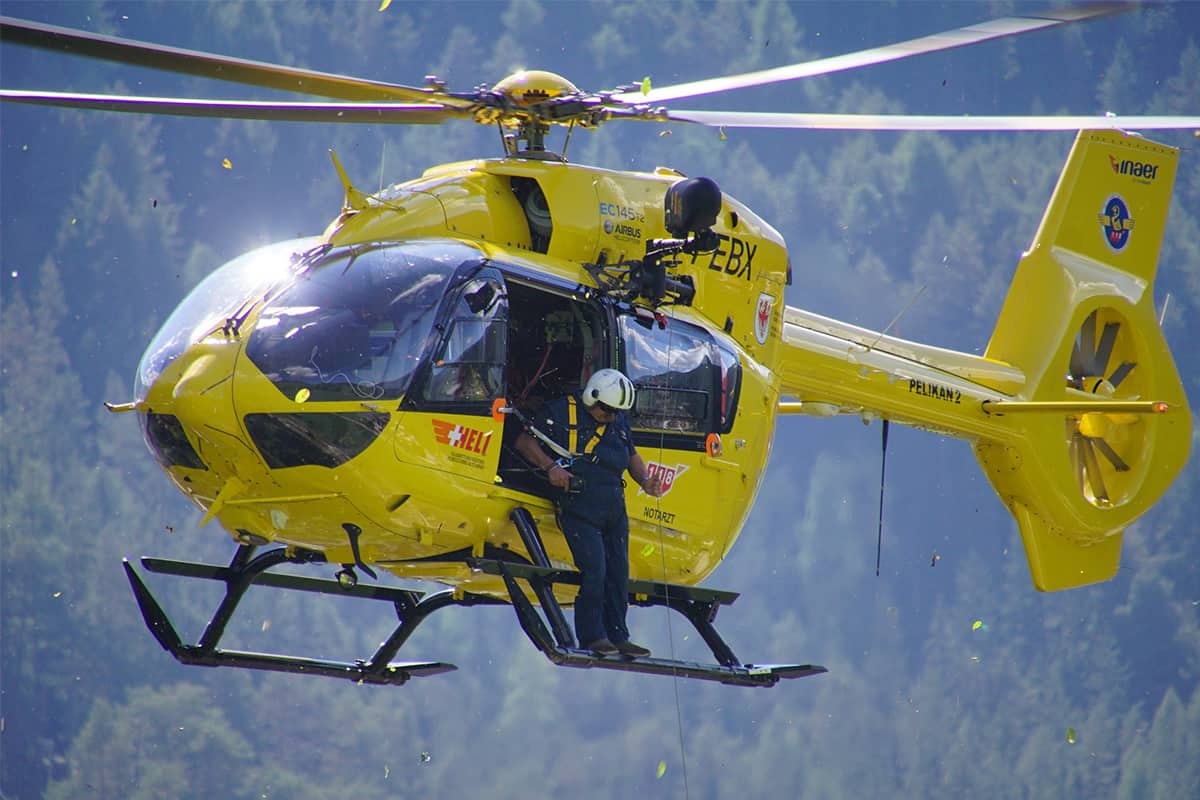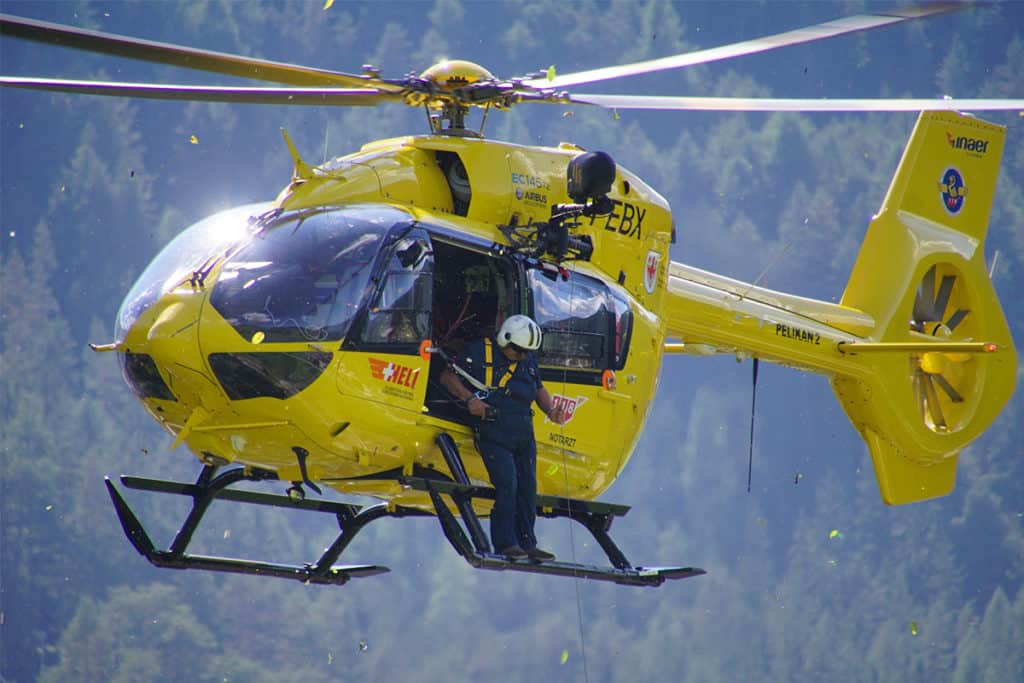
When I moved from flying a single-engine helicopter to a helicopter with two engines I thought I would never have to worry about an engine failing again. I was soon to learn that not all twin-engined helicopters can always fly on just one engine!
If power from the remaining engine is not sufficient to overcome the weight of the helicopter then the helicopter will not be able to remain flying. Weight, atmospheric conditions, remaining engine power & flight technique all dictate if a twin-engine helicopter can remain flying on only one engine.
The first twin-engined helicopter I flew was a Sikorsky S76A Model that did not have enough performance to fly away in certain conditions if an engine were to fail. In this article, I want to tell you all about what allows a twin-engine helicopter to continue flying and what doesn’t.
What Factors Affect Twin Engine Helicopter Flying Performance?
In the S76 I flew there were many factors that dictated whether the helicopter could remain flying if one of its engines quit. Depending on if the helicopter was taking off, in the cruise, or landing would also dictate what course of action the other pilot and I would have to take.
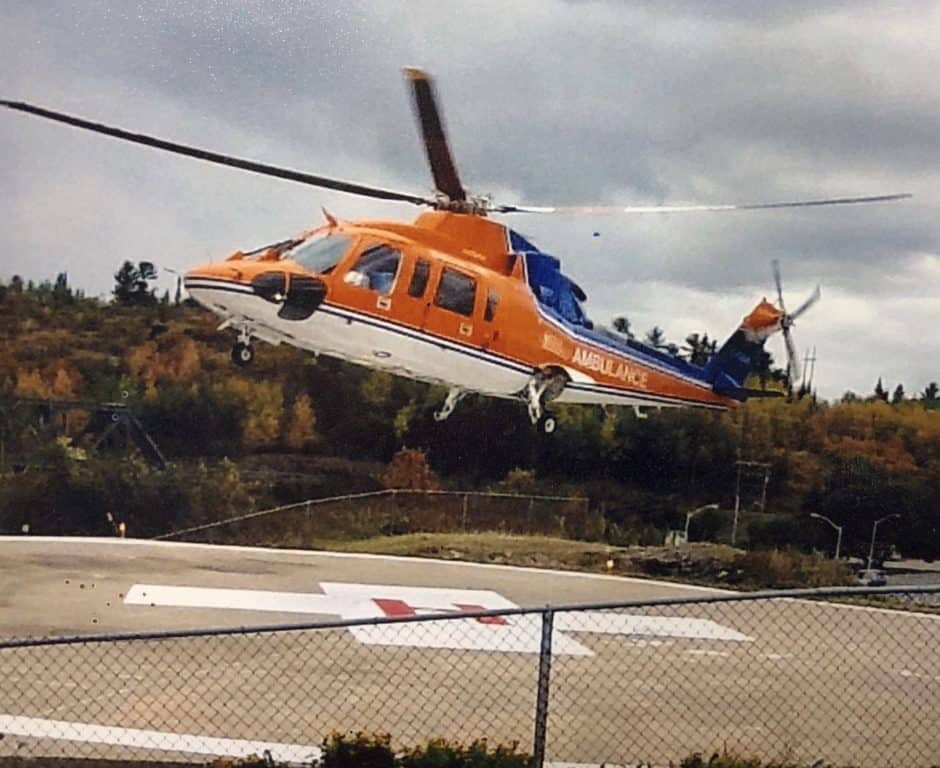
It’s obvious that if a helicopter has two powerful engines then flying on just one engine is no problem, but for older helicopters that don’t have today’s technological advances that can sometimes be an issue. The helicopter I flew was from the 1980’s and needed careful calculations to be completed before each liftoff to ensure safety could be maintained if an engine were to stop.
There are several factors that all play a key role in determining if a twin-engined helicopter could keep flying in the event that a donkey quits (a common nickname for a helicopter engine!):
Weight
The heavier the helicopter weighs, the more power is needed from the remaining engine to keep it flying. If the weight is more than the lift being produced, then the helicopter will begin to descend. The less power there is to produce the lift, the faster the helicopter will descend.
To be able to allow the helicopter to safely fly away or maintain altitude in cruise the weight needs to be controlled by either reducing the number of passengers and cargo, or by reducing how much fuel is carried. This calculation needs to be done before the helicopter is loaded with passengers or fuel. Referring to the aircraft performance charts will give a maximum aircraft weight for the current altitude it is to be operated at and the temperature at that altitude.
By staying under that maximum weight limit, the helicopter should be able to fly the selected profile (more on this later) to either reject the landing back to the helipad, fly away or maintain altitude once in cruise. If the aircraft weighs more than this limit, then the helicopter will not be able to fly away or reject to safety – this is where incidents and accidents happen.
Once a helicopter gets over that calculated weight limit the pilots can have several options:
- Ignore it and hope for the best – Not recommended!
- Offload some fuel – Not an option when away from the hanger
- Offload passengers or cargo – They will not be happy
- Sit on the ground with the engines running and burn off fuel
None of these options are very professional, hence why calculations need to be made by the pilot/s to ensure the right amount of fuel is loaded. Fuel is the easiest variable to control.
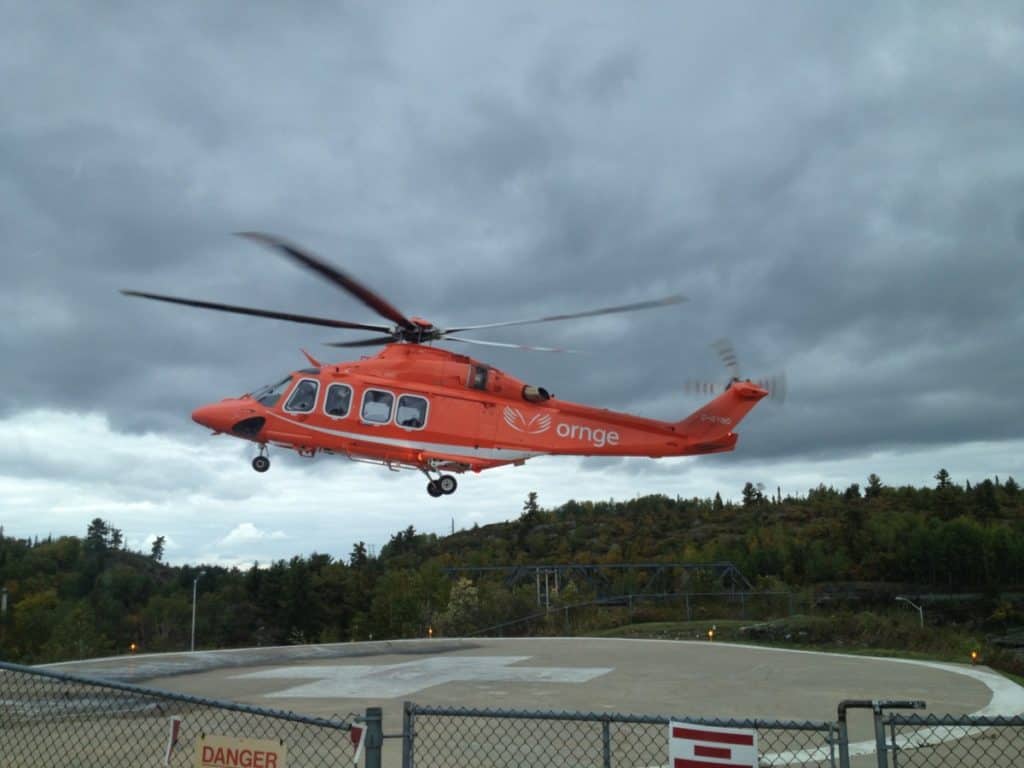
Density Altitude
Air molecules are what helicopter’s rotor blades work on to create lift. They are also what is used by the engines to mix with fuel and burn to produce power. The fewer air molecules there are in a given parcel of air, the worse the helicopter performs. The effect of temperature and altitude on these air molecules also dictates how many are in that same parcel of air. For a helicopter to perform as its performance charts stipulate, the pilot/s need to know the current atmospheric conditions known as density altitude.

Join My Newsletter & Get Great Tips, Information and Experiences To Help You Become a Superb Pilot!
Density altitude is a calculation that takes into effect the height at which the helicopter is operating above sea level and the temperature at that given height. Without going into too much detail in this article, when the temperature at a given location is hotter than what it should be based on the International Standard Atmosphere (ISA), the helicopter will operate like it’s at a higher altitude, thus performance is lower.
For Example:
On an ISA Day:
A hospital helipad at 5000 feet above sea level should be around +5°C/41°F
This is what helicopter performance charts are based on and the helicopter performs like it’s at 5000ft
On a Warmer than ISA Day:
The same hospital helipad at 5000 feet above sea level is now around +15°C/59°F
The same helicopter would now perform like it was at 6000 feet
This means the air is less dense, therefore the helicopter performance is reduced. For our ambulance operations, anytime the air temperature rose above 20°C/68°F when flying the S76, we had to start taking less fuel to be able to safely fly away on a single engine from the hospital or maintain altitude if in cruise flight.
If we took too much fuel, the helicopter would not have the power (based on its performance charts) to operate safely in the event of an engine failure and would begin to descend no matter how we tried to fly it. An uncontrollable descent to an area that is not clear is always going to lead to a bad outcome!
By looking at the current density altitude on the performance charts, we get given the maximum weight value mentioned above.
Flight Profile Conformity
To be able to safely fly away or reject a takeoff in the event that an engine quits on a twin, the manufacturer publishes set profiles the pilot must fly to. By flying to these profiles and following the correct emergency procedure the helicopter will be guaranteed to perform as the profile shows. By selecting and flying a profile, the helicopter should clear any obstacle by at least 15 feet providing the pilot has done their performance and obstacle clearance calculations correctly.
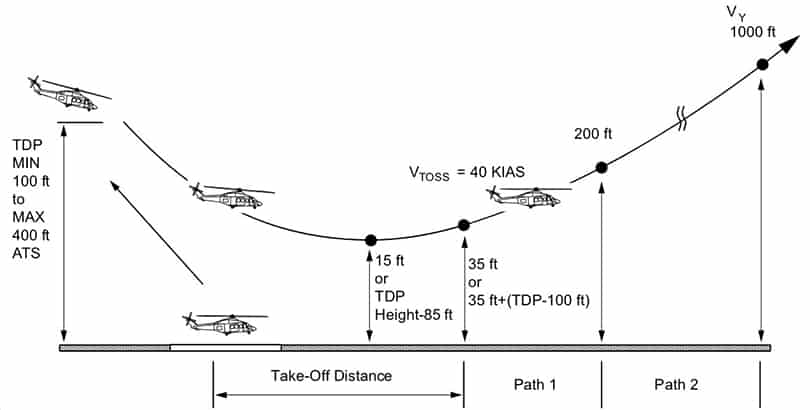
For example, during this takeoff, the pilot climbs the helicopter vertically and backward to keep the helipad in sight until they reach their calculated height between 100ft and 400ft above the helipad. This height is known as the ‘TDP’-Takeoff Decision Point.
If an engine fails during the vertical climb to TDP the pilots reject the takeoff and returns back to the helipad using the second engine without any problems.
Once the helicopter reaches TDP, the decision is made to fly away. If an engine fails from this point onwards the helicopter will descend during the immediate seconds following the engine failure but will begin to climb once the aircraft begins to gain aerodynamic performance.
It is this slight descent, climb rate, and distance covered during those first few seconds that the manufacturers’ test pilot’s calculated during the helicopter’s initial certification. By following the selected profile, the helicopter should be able to fly away after reaching TDP and clear any obstacles in the departure path by at least 15ft one just one engine.
If a pilot is not following the recommended takeoff and landing profiles then there is no guarantee that the helicopter will perform as expected. The manufacturer issues various takeoff and landing profiles to cover pretty much any takeoff and landing scenario a pilot could face. Selecting the correct profile is the pilots’ responsibility and then adjusting it to meet the current aircraft weight, atmospheric conditions, and surrounding obstacles is crucial for success.
What are Helicopter Performance Classes?
All Helicopters fall under one of three performance classes based on how they perform when an engine fails. According to ICAO (International Civil Aviation Organization), they recommend the following classes for operating helicopters in and around helipads and airports:
Performance Class 1
“A helicopter with performance such that, in the case of a critical power unit failure, it is able to land on the rejected takeoff area or safely continue the flight to an appropriate landing area, depending on where the failure occurs”.
The most powerful twin-engined helicopters that are able to fly away and climb on only one engine fall into this performance class.
Performance Class 2
“A helicopter with performance such that, in the case of a critical power unit failure, it is able to safely continue the flight, except where the failure occurs prior to a defined point after takeoff or after a defined point before landing, in which case a forced landing may be required”.
Twin-engine helicopters with low power engines or that are not able to keep the helicopter in a straight and level flight condition after an engine failure fall into this performance class.
Performance Class 3
“A helicopter with performance such that in case of a power unit failure at any point in the flight profile, a forced landing must be performed”.
All single-engine helicopters fall into the performance class.
These performance classes are what restricts helicopters going into and out of certain helipads. For example, a helipad located on the top of a tall building in a downtown city will be restricted to helicopters with only Performance Class 1. This is so that in the event of that helicopter having an engine failure at the worst possible time the helicopter will be able to land safely on the helipad or fly away.
A helicopter without that performance could end up in a tragic accident on the street below causing many fatalities.
What are Category A Helicopters Vs Category B Helicopters?
Every helicopter type that is manufactured is certified as a Category A or B helicopter based on its design, systems, and performance capabilities. In the industry, these are known as Cat A & Cat B, and depending on what category the helicopter is certified in will dictate what the pilot can and cannot do with it.
Cat A is given to those helicopters with multiple engines and isolation systems that are capable of performing a rejected takeoff or fly-away capability during single-engine operations when performance data & flight profiles are adhered to.
To remain in Cat A performance the helicopter must be kept within the performance limitations set out in the Cat A performance charts. Once the weight of the helicopter exceeds the Cat A performance limit for the given atmospheric conditions, the helicopter will fall into the Cat B performance criteria.
When a helicopter with two engines needs to depart or land at a hostile environment, say an oil rig in the ocean or a downtown rooftop helipad the use of a manufacturer-issued Cat A flight profile must be used. The performance calculations must be completed for the height, temperature, weight, and surrounding obstacles before completing the maneuver to ensure that if an engine were to fail at the worst possible time, the helicopter will be able to be flown just as the profile dictates to ensure the safety of the people in the aircraft, any bystanders, and the aircraft.
Cat B is given to those helicopters that cannot meet the performance criteria to safely reject a takeoff or fly-away in the event of a power unit failure.
For those of us who fly around in single-engine or underpowered twin helicopters, the best we can do is minimize our exposure to risk by using correct flying techniques and trying to keep clear landing spots within gliding distance. Sometimes this can be impossible to do, hence why certain helicopter operations are required to be completed using a twin-engine Cat A helicopter only. These operations can be mandated by the country’s own aviation authority, local governments, or the customer.
Typical operations requiring Cat A helicopters are:
- Offshore Oil & Gas Transportation
- Search & Rescue
- City-Based Power Line Patrol
- MedEvac
This is one of the main reasons why my previous employer changed the ambulances from S76’s to AW139’s because, in the hot summer months, the S76 had to be flown with such small fuel quantities to meet the Cat A, Performance Class 1 requirements to land at the downtown rooftop hospital helipads, that it made the helicopters service range incredibly small.
To Finish
All twin-engine helicopters can safely fly on one engine providing the weight is kept under that calculated limit for that flight, however on older and underpowered machines that weight can be so low it can make the helicopter useless, and therefore the pilot has to select Cat B profiles to operate to. This takes the helicopter from a Performance Class 1 to a Performance Class 2.
When a helicopter requires the single-engine performance to allow the helicopter to be useful, only the most powerful and more expensive machines are up to the task. If the customer requires the highest levels of safety then the wallet must be opened further.
Moving from the limited Cat A performance of the S76A to the immensely powerful AW139 was a real eye-opener for me of just how noneventful an engine failure was in the AW139 no matter where and when we flew it!
Further Reading
If you found this helpful you might like these other articles too:

